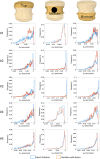A novel approach to evaluate the effects of artificial bone focal lesion on the three-dimensional strain distributions within the vertebral body
- PMID: 34061879
- PMCID: PMC8168867
- DOI: 10.1371/journal.pone.0251873
A novel approach to evaluate the effects of artificial bone focal lesion on the three-dimensional strain distributions within the vertebral body
Abstract
The spine is the first site for incidence of bone metastasis. Thus, the vertebrae have a high potential risk of being weakened by metastatic tissues. The evaluation of strength of the bone affected by the presence of metastases is fundamental to assess the fracture risk. This work proposes a robust method to evaluate the variations of strain distributions due to artificial lesions within the vertebral body, based on in situ mechanical testing and digital volume correlation. Five porcine vertebrae were tested in compression up to 6500N inside a micro computed tomography scanner. For each specimen, images were acquired before and after the application of the load, before and after the introduction of the artificial lesions. Principal strains were computed within the bone by means of digital volume correlation (DVC). All intact specimens showed a consistent strain distribution, with peak minimum principal strain in the range -1.8% to -0.7% in the middle of the vertebra, demonstrating the robustness of the method. Similar distributions of strains were found for the intact vertebrae in the different regions. The artificial lesion generally doubled the strain in the middle portion of the specimen, probably due to stress concentrations close to the defect. In conclusion, a robust method to evaluate the redistribution of the strain due to artificial lesions within the vertebral body was developed and will be used in the future to improve current clinical assessment of fracture risk in metastatic spines.
Conflict of interest statement
The authors have declared that no competing interests exist.
Figures







